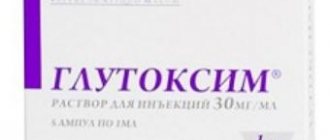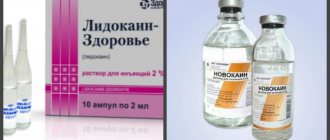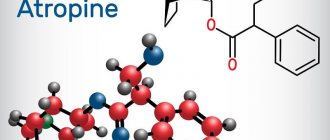Pharmacological properties of the drug Cerucal
Pharmacodynamics. A blocker of dopamine and serotonin receptors, inhibits chemoreceptors in the brain, weakens the sensitivity of the visceral nerves that transmit impulses from the pylorus and duodenum to the vomiting center. Through the hypothalamus and parasympathetic division of the autonomic nervous system, it regulates and coordinates the motor activity of the upper digestive tract. Increases the tone of the stomach and intestines, accelerates gastric emptying, reduces gastrostasis, prevents pyloric and esophageal reflux, stimulates intestinal motility. It has an antiemetic effect against vomiting of various origins (except for vomiting of a psychogenic and vestibular nature). Normalizes bile secretion, reduces spasm of the sphincter of Oddi, does not change its tone, eliminates dyskinesia of the gallbladder. Pharmacokinetics. Quickly and completely absorbed after oral administration. The maximum concentration in blood plasma is achieved 30–120 minutes after administration. The onset of action on the digestive tract is observed 20–40 minutes after ingestion. The antiemetic effect persists for 12 hours. 13–30% of metoproclamide is bound to plasma proteins. Volume of distribution - 3.5 l/kg. Metabolized in the liver. The half-life is 4–6 hours. Over 24–72 hours, up to 80% of the administered dose is excreted in the urine, about 30% unchanged. Penetrates through the BBB and placental barrier, excreted in breast milk. With intravenous administration, the onset of action on the digestive tract is noted after 1-3 minutes, with intramuscular administration - after 10-15 minutes.
More information about release forms and packaging
Cerucal is available in the form:
- tablets;
- solution for injection.
The solution in ampoules is administered intravenously or intramuscularly.
Blisters with white tablets are packed in cardboard boxes (50 tablets per package). Each tablet contains 10 mg of the active substance - metoclopramide hydrochloride. The solution for intramuscular and intravenous injection is sold in two-milligram ampoules with the same content of the active ingredient as in tablets - 10 mg (5 mg of metoclopramide per 1 ml of medicine).
Both forms of Cerucal provide the same therapeutic effect. The tablets have a prolonged effect (up to 6 hours), and therefore they are often prescribed in the complex treatment of chronic pathologies of the gastrointestinal tract. But the drug administered intramuscularly or intravenously does not act for so long - only about 2 hours. But the effect after the injection occurs much faster than after taking the pill.
Cerucal injections are usually prescribed in cases of urgent need to relieve symptoms of indigestion, as well as in case of vomiting, which does not allow the tablet to stay in the stomach for at least 20 minutes.
Use of the drug Cerucal
Tablets Adults and adolescents over the age of 14 years are prescribed 10 mg orally 3-4 times a day. For children aged 3 to 14 years, the recommended single dose is 0.1 mg/kg, the maximum daily dose is 0.5 mg/kg. The tablets are taken orally, approximately 30 minutes before meals. The duration of treatment depends on the severity and course of the disease. The usual duration of treatment is 4–6 weeks. In some cases, treatment can be continued for up to 6 months. In the presence of renal failure, the dose of the drug is selected taking into account the severity of renal dysfunction. Solution for injection The injection solution is administered intramuscularly or intravenously slowly. Adults and adolescents over the age of 14 years are administered intramuscularly and intravenously 2 ml of Cerucal solution 3–4 times a day (single dose is 10 mg, daily dose is 30–40 mg of metoclopramide). For children aged 3 to 14 years, the recommended single dose is 0.1 mg/kg body weight, the maximum daily dose is 0.5 mg/kg. Prescription of metoclopramide in high doses for nausea and vomiting caused by the use of cytostatic agents: Dosage regimen 1 By short-term intravenous drip infusion (over 15 minutes), Cerucal is administered at a dose of 2 mg/kg 30 minutes before the start of the administration of the cytostatic agent, as well as after 1.5; 3.5; 5.5 and 8.5 hours after the use of a cytostatic agent. Dosage regimen 2 By continuous intravenous drip infusion, Cerucal is administered at a dose of 1 (0.5) mg/kg over an hour, starting 2 hours before the use of a cytostatic agent, then at a dose of 0.5 (0.25) mg/kg within an hour for 24 hours after using a cytostatic agent. Cerucal is used throughout the entire period of treatment with a cytostatic agent. Each short-term intravenous drip infusion is carried out within 15 minutes after the previous dilution of the dose of Cerucal in 50 ml of infusion solution. Cerucal for injection can be dissolved with isotonic sodium chloride solution or 5% glucose solution. Note Cerucal injection solution cannot be mixed with alkaline infusion solutions.
Cerucal 5mg/ml 2ml 10 pcs. solution for intravenous and intramuscular administration
pharmachologic effect
A specific blocker of dopamine receptors, weakens the sensitivity of the visceral nerves that transmit impulses from the pylorus and duodenum to the vomiting center. Through the hypothalamus and parasympathetic nervous system, it has a regulating and coordinating effect on the tone and motor activity of the upper gastrointestinal tract (including the tone of the lower digestive sphincter at rest). Increases the tone of the stomach and intestines, accelerates gastric emptying, reduces hyperacid stasis, prevents pyloric and esophageal reflux, stimulates intestinal motility.
Composition and release form Cerucal 5 mg/ml 2 ml 10 pcs. solution for intravenous and intramuscular administration
Solution - 1 ml/1 amp.:
- Active substance: metoclopramide hydrochloride 5 mg/10 mg.
- Excipients: sodium sulfite, disodium EDTA, sodium chloride, water for injection.
2 ml - ampoules (5) - contour plastic packaging (1) - cardboard packs.
Description of the dosage form
The solution for intravenous and intramuscular administration is transparent, colorless.
Directions for use and doses
IM or slow IV.
Adults and adolescents over 14 years of age: 1 ampoule (10 mg metoclopramide) 3-4 times a day.
Children from 3 to 14 years of age: the therapeutic dose is 0.1 mg metoclopramide/kg body weight, the maximum daily dose is 0.5 mg metoclopramide/kg body weight.
In case of renal dysfunction, the dose of the drug is selected according to the severity of renal dysfunction.
| Creatinine clearance | Metoclopramide dose |
| up to 10 ml/min | 10 mg 1 time per day |
| from 11 to 60 ml/min | daily dose of 15 mg, divided into two doses (10 mg + 5 mg) |
Prevention and treatment of nausea and vomiting caused by the use of cytostatics:
Scheme 1.
Short-term drip infusion (over 15 minutes) at a dose of 2 mg/kg half an hour before the start of treatment with a cytostatic agent, and then 1.5 hours, 3.5 hours, 5.5 hours and 8.5 hours after the use of cytostatics.
Scheme 2.
Long-term drip infusion at a dose of 1.0 or 0.5 µg/kg per hour, starting 2 hours before using the cytostatic agent, then at a dose of 0.5 or 0.25 mg/kg per hour over the next 24 hours after using the cytostatic agent.
The drip infusion is carried out briefly for 15 minutes after preliminary dilution of the dose of cerucal in 50 ml of infusion solution.
Cerucal injection solution can be diluted with isotonic sodium chloride solution or 5% glucose solution.
Cerucal is used throughout the entire period of treatment with cytostatic agents.
Pharmacokinetics
Vd is 2.2 - 3.4 l/kg.
Metabolized in the liver. The half-life is from 3 to 5 hours, in case of chronic renal failure - 14 hours. It is excreted by the kidneys during the first 24 hours unchanged and in the form of metabolites (about 80% of a single dose). Easily penetrates the blood-brain barrier and is excreted in breast milk.
Indications for use Cerucal 5mg/ml 2ml 10 pcs. solution for intravenous and intramuscular administration
- Vomiting and nausea of various origins;
- atony and hypotension of the stomach and intestines (in particular, postoperative);
- biliary dyskinesia, reflux esophagitis, functional pyloric stenosis;
- to enhance peristalsis during radiopaque studies of the gastrointestinal tract;
- gastric paresis in diabetes mellitus;
- as a means of facilitating duodenal intubation (to speed up gastric emptying and move food through the small intestine).
Contraindications
- Hypersensitivity to metoclopramide;
- pheochromocytoma (possible hypertensive crisis due to the release of catecholamines);
- intestinal obstruction, intestinal perforation and gastrointestinal bleeding;
- prolactin-dependent tumor;
- epilepsy and extrapyramidal movement disorders, first trimester of pregnancy and lactation, age up to 2 years.
With caution: with arterial hypertension, liver dysfunction, hypersensitivity to procaine and procainomide, children aged 2 to 14 years
During the 2nd and 3rd trimesters of pregnancy, the drug is prescribed only for health reasons.
For patients with reduced renal function, the drug is prescribed in reduced doses.
Due to the sodium sulfite content, the drug should not be prescribed to patients with bronchial asthma with hypersensitivity to sulfite.
Application Cerucal 5mg/ml 2ml 10 pcs. solution for intravenous and intramuscular administration during pregnancy and lactation
Contraindicated for use in the first trimester of pregnancy and lactation.
In the second and third trimesters of pregnancy, the drug is prescribed only for health reasons
Use in children
Cannot be prescribed to children under 2 years of age.
Prescribe with caution to children aged 2 to 14 years. In adolescents, monitor for the possible development of side effects; if they occur, the drug is discontinued.
special instructions
During the treatment period, it is necessary to refrain from driving vehicles and engaging in potentially hazardous activities that require increased concentration and speed of psychomotor reactions.
During treatment, patients are prohibited from drinking alcohol.
In adolescents and in patients with severely impaired renal function, monitor for the possible development of side effects; if they occur, the drug is discontinued.
Not effective for vomiting of vestibular origin.
During the use of metoclopramide, distortion of data on laboratory parameters of liver function and determination of the concentration of aldosterone and prolactin in plasma is possible.
Overdose
Symptoms: drowsiness, confusion, irritability, anxiety, convulsions, extrapyramidal movement disorders, dysfunction of the cardiovascular system with bradycardia and arterial hypo- or hypertension. In mild forms of poisoning, symptoms disappear 24 hours after discontinuation of the drug. Depending on the severity of symptoms, it is recommended to monitor the patient’s vital functions. Fatal cases of poisoning due to overdose have not yet been identified.
Treatment: symptomatic. Extrapyramidal disorders are eliminated by slow administration of biperiden (dose for adults - 2.5 - 5 mg; manufacturer's recommendations should be followed). Diazepam may be used.
Side effects Cerucal 5mg/ml 2ml 10 pcs. solution for intravenous and intramuscular administration
From the nervous system: sometimes there may be a feeling of fatigue, headaches, dizziness, fear, anxiety, depression, drowsiness, tinnitus; in some cases, mainly in children, dyskinetic syndrome (involuntary tic-like twitching of the muscles of the face, neck or shoulders) may develop. Extrapyramidal disorders may appear: spasm of the facial muscles, trismus, rhythmic protrusion of the tongue, bulbar type of speech, spasm of extraocular muscles (including oculogyric crisis), spastic torticollis, opisthotonus, muscle hypertonicity. Parkinsonism (tremor, muscle twitching, limited mobility, the risk of development in children and adolescents increases when the dose exceeds 0.5 mg/kg/day) and tardive dyskinesia (in elderly patients with chronic renal failure). In isolated cases, severe neuroleptic syndrome may develop.
With long-term treatment with Cerucal, elderly patients may develop symptoms of parkinsonism (tremor, muscle twitching, limited mobility) and tardive dyskinesia.
From the hematopoietic system: agranulocytosis.
From the cardiovascular system: supraventricular tachycardia, hypotension, hypertension.
From the gastrointestinal tract: constipation, diarrhea, dry mouth.
From the endocrine system: with long-term use of the drug, gynecomastia (enlargement of the mammary glands in men), galactorrhea (spontaneous leakage of milk from the mammary glands) or menstrual irregularities may occur; If these phenomena develop, metoclopramide is discontinued.
Drug interactions
Incompatible with alkaline infusion solutions.
Reduced effect of anticholinesterase drugs.
Enhances the absorption of antibiotics (tetracycline, ampicillin), paracetamol, levodopa, lithium and alcohol.
Reduces the absorption of digoxin and cimetidine.
Strengthens the effect of alcohol and drugs that depress the central nervous system.
Antipsychotic drugs should not be prescribed simultaneously with metoclopramide to avoid a possible increase in extrapyramidal disorders.
May affect the effect of tricyclic antidepressants, monoamine oxidase inhibitors (MAOIs) and symptomatic agents.
Reduces the effectiveness of therapy with H2-histamine blockers.
Increased risk of developing hepatotoxicity when combined with hepatotoxic agents.
Reduces the effectiveness of pergolide and levodopa.
Increases the bioavailability of cyclosporine, which may require monitoring its concentration.
Increases the concentration of bromocriptine.
When cerucal is prescribed simultaneously with thiamine (Vitamin B1), the latter quickly disintegrates.
Contraindications to the use of the drug Cerucal
Hypersensitivity to the drug; pheochromocytoma; mechanical intestinal obstruction; intestinal perforation and gastrointestinal bleeding; prolactin-dependent tumors; in patients with epilepsy or in patients with increased convulsive readiness (extrapyramidal movement disorders); first trimester of pregnancy and lactation period; in newborns and children under 3 years of age. For children aged 3–14 years, as well as pregnant women in the 2nd–3rd trimester, metoclopramide is prescribed only for health reasons. For patients with reduced renal function, the drug is prescribed in reduced doses. Due to the sodium sulfite content, Cerucal injection solution cannot be prescribed to asthma patients with hypersensitivity to sulfite.
At what age is it prescribed?
In the form of injections, Cerucal can be used in children over 2 years of age, since the liquid form allows you to accurately dose the active substance of the drug. In this case, for children aged two to 14 years, injections are used only as prescribed by a doctor, and if any side effects occur, the medication is immediately discontinued. Most often, such injections are used as an emergency remedy that helps stop vomiting, hiccups or nausea of various origins.
The tablet drug is not used in the treatment of patients under 14 years of age. This is due not only to the solid form (problems with swallowing), but also to a greater risk of overdose.
Side effects of the drug Cerucal
Rarely, mainly when metoclopramide is used in higher doses, patients may experience fatigue, headache, dizziness, fear, anxiety and diarrhea. In some cases, mainly in children, dyskinetic syndrome (involuntary tic-like twitching of the muscles of the face, neck or shoulders) may develop. After discontinuation of the drug, these phenomena weaken within a few hours; it is possible to immediately eliminate them with the intravenous administration of biperiden (the manufacturer’s recommendations should be taken into account). For sedation, administration of diazepam is indicated. After prolonged treatment with metoclopramide, some elderly patients developed parkinsonism (tremor, muscle twitching, limited mobility) and tardive dyskinesia. After longer use of the drug, occasionally, due to stimulation of prolactin secretion, gynecomastia in men, galactorrhea or menstrual irregularities may occur; If these phenomena develop, stop taking metoclopramide. In adolescents and patients with severe renal impairment, the occurrence of side effects should be especially carefully monitored, and if they develop, the drug should be stopped immediately.
What does the medicine help with?
The injection helps in the following cases:
- Recovery after operations and manipulations in the digestive system.
- Gastritis.
- Gastrointestinal dysfunctions.
- Intoxication.
- Pancreatitis.
- Overdose of pharmacological agents.
- Carrying out endoscopy.
- Stomach upset.
- Reflux esophagitis.
- Cholecystitis, etc.
The medicine is used in chemotherapy or treatment with cytostatic drugs for patients suffering from tumor diseases.
The solution is often given through a glucose and saline drip. It has an antiemetic effect and can improve a person’s well-being for a long time.
Contraindications
The medicine is not recommended for use if you are intolerant to its components. It should not be used for intestinal obstruction or pyloric stenosis. A prolactin-dependent tumor or pheochromocytoma serves as a medical outlet for the administration of Cerucal. It is contraindicated in case of hypertension, extrapyramidal disorders or epilepsy.
The drug is not intended for children under 2 years of age.
It is not used in the early stages of pregnancy. There is no information on the practice of administering it to pregnant women, but at this time it is not recommended to use any pharmacological agents due to the threat of spontaneous abortion or developmental abnormalities in the fetus.
A relative contraindication is lactation. The medicine passes into breast milk, so during the period of therapy, feeding should be stopped and the child should be switched to other types of food.
Side effect
If the doctor’s recommendations are not followed and the instructions for use are ignored, the development of negative reactions in the body is possible.
What do you think are the most important factors when choosing a medical facility?
Most often after the injection, the following are noted:
- dizziness;
- constipation;
- changes in heart rate;
- flatulence;
- sleep disorders;
- increased anxiety;
- pressure surges;
- spasms of small muscles;
- dry mouth;
- tinnitus, etc.
Special instructions for the use of the drug Cerucal
Impact on the ability to drive vehicles. Even when taken as recommended, metoclopramide may significantly impair reaction time and the ability to drive or operate potentially dangerous machinery. This effect is especially pronounced with the simultaneous use of alcohol. Due to the content of sodium sulfite in the Cerucal injection solution, in some cases, mainly in patients with asthma, hypersensitivity reactions to the drug may occur, which are manifested by nausea, diarrhea, shortness of breath, an acute attack of asthma, impaired consciousness or anaphylactic shock. The severity of these reactions is purely individual; in some cases they can pose a threat to the patient’s life.
How does it work
The main active ingredient in Cerucal is metoclopramide hydrochloride. It blocks the functioning of receptors through which impulses from irritated areas of the gastrointestinal tract (stomach and duodenal mucosa) are transmitted to the vomiting center of the brain. As a result, the gag reflex is suppressed.
Another direction of action of the drug is to increase the tone of the smooth muscles of the stomach. This helps to increase the speed at which food enters the intestines. At the same time, the drug stimulates the protection of the esophagus from the reflux of stomach contents into it, and the stomach from the entry of bile into it. That is, the medicine prevents such unpleasant symptoms as belching and heartburn. At the same time, Cerucal has a positive effect on intestinal motility, which ensures timely emptying and eliminates another common childhood (and not only) problem - constipation.
The drug helps overcome nausea and revitalizes the gastrointestinal tract.
Interactions of the drug Cerucal
Anticholinergics may reduce the effect of metoclopramide. Metoclopramide may interfere with the absorption of other drugs. On the one hand, there may be a slowdown in the absorption of digoxin and cimetidine, on the other hand, an acceleration in the absorption of antibiotics, paracetamol and alcohol. In addition, metoclopramide may enhance the effects of alcohol and sedatives. In order to prevent a possible increase in the severity of extrapyramidal disorders, antipsychotics should not be prescribed simultaneously with metoclopramide. Metoclopramide may interfere with the action of tricyclic antidepressants, MAO inhibitors and sympathomimetic agents. Due to the content of sodium sulfite in the injection solution, thiamine (vitamin B1), taken simultaneously with Cerucal, can be quickly broken down in the body.
Compatibility with other drugs
"Cerucal" in solution should not be mixed with drugs for infusions that have an alkaline environment. Under the influence of "Cerucal", the effect of anticholinesterase drugs is reduced, and the absorption of cimetidine, paracetamol, some antibiotics, digoxin, levodopa and lithium preparations is enhanced. When combined with drugs that depress the central nervous system, their effect on the brain will be stronger.
If Cerucal is prescribed together with antipsychotics, the risk of extrapyramidal disorders will increase. When treated with Cerucal, the effectiveness of antihistamines may decrease. If this medicine is used with hepatotoxic drugs, the likelihood of liver damage increases. When used simultaneously with vitamin B1, a rapid breakdown of thiamine is observed.






